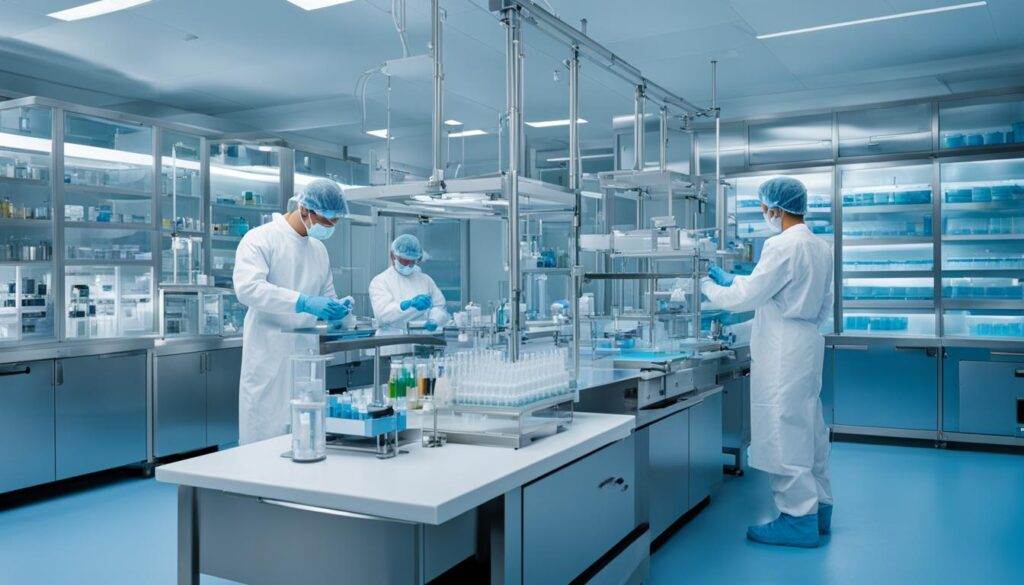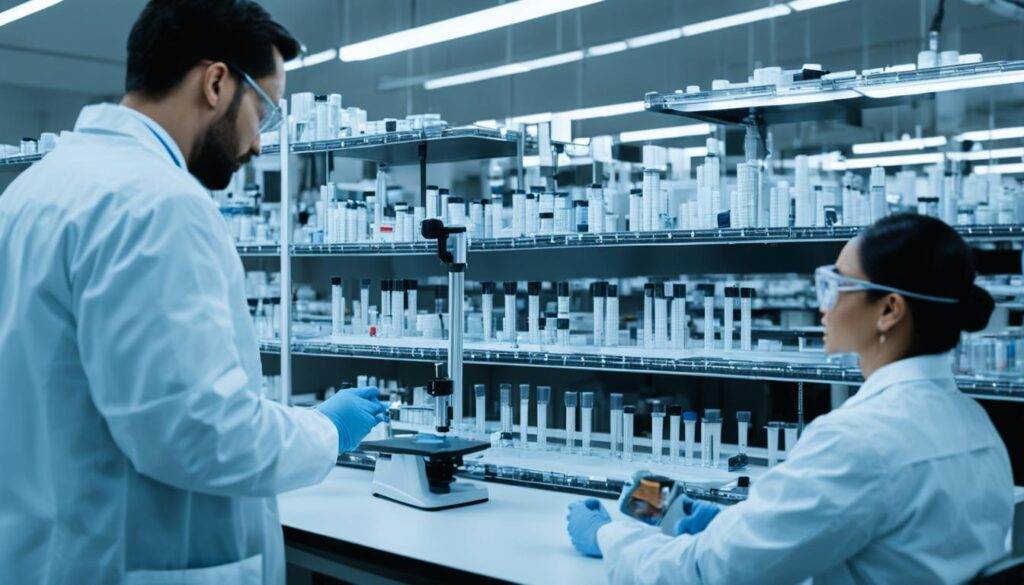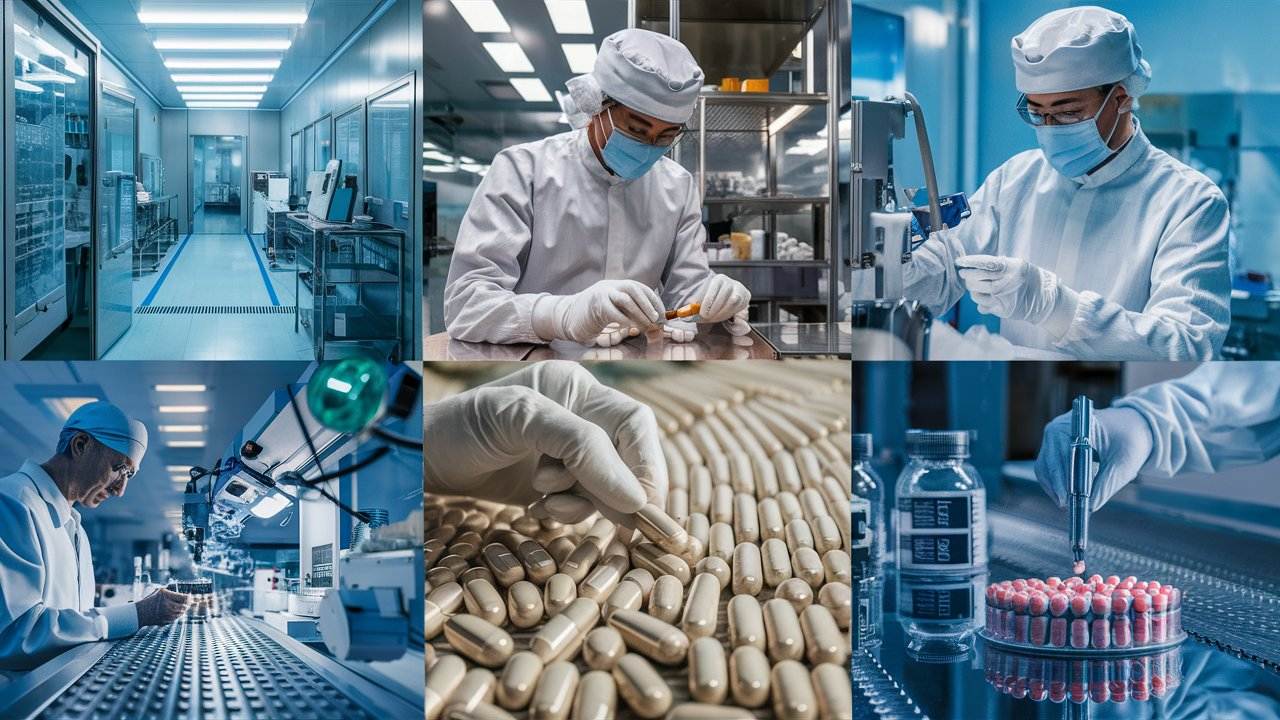Knowing the types of quality control in the pharmaceutical industry is vital for ensuring excellence in pharmaceutical manufacturing, from raw material testing to final product inspection.
Defining Quality Control in Pharmaceutical Manufacturing
What is Quality Control (QC) in the Pharmaceutical Industry?
Quality Control (QC) in the pharmaceutical industry is all about making sure that medicines are safe and work well. It involves checking raw materials, watching how drugs are made, and testing the final products to see if they meet certain standards. If a batch of medicine fails these tests, it gets fixed or thrown away to stop unsafe drugs from getting to patients.
Importance of QC for Patient Safety and Product Efficacy
Quality control is super important because it helps keep patients safe and ensures that medicines do what they’re supposed to do. Good QC practices can catch problems like contamination early on, which means fewer chances of harmful drugs reaching people. When QC isn’t done right, it can lead to serious health risks. That’s why having strong quality checks is essential for everyone’s safety.
Regulatory Requirements and Guidelines for QC
Regulatory requirements help shape how quality control works in the pharmaceutical world. Groups like the FDA (Food and Drug Administration) and EMA (European Medicines Agency) set strict rules that must be followed. Good Manufacturing Practices (GMP), Good Laboratory Practices (GLP), and International Conference on Harmonisation (ICH) guidelines provide clear steps for keeping everything compliant during drug development. Following these rules not only ensures product quality but also helps build trust with consumers and healthcare providers.
Key Elements of a Robust QC System
A strong quality control system has several key parts:
- Risk Management Strategies: Spotting potential problems early can help fix issues before they grow.
- Thorough Documentation Practices: Keeping good records makes sure everything is accountable.
- Regular Audits: Frequent checks help keep everything on track with set protocols.
- Training Programs: Teaching staff about their roles in QC helps everyone know what to do.
- Continuous Improvement Initiatives: Updating procedures regularly based on new information keeps things efficient.
These elements work together to make sure product quality stays top-notch throughout the manufacturing process.
Challenges in Implementing Effective QC
Putting effective quality control into action can be tough due to various reasons:
- Resource Limitations: Smaller companies might have tight budgets that limit their ability to invest in full-scale QC systems.
- Complex Manufacturing Processes: The many steps involved in making drugs can make monitoring tricky.
- Evolving Regulations: Staying updated with changing rules takes constant effort.
- Technological Advancements: While new tech can improve processes, it may also bring new challenges.
Facing these challenges while sticking to strict regulatory standards is key for success.
Understanding quality control in pharmaceutical manufacturing shows just how important it is for patient safety and following regulations. A solid QC system not only protects public health but also boosts efficiency within companies dedicated to providing safe medications. By focusing on these practices, businesses can earn trust from consumers while ensuring their products meet high-quality standards.
Types of Quality Control Tests
Quality control (QC) in the pharmaceutical industry is super important. It helps make sure that products are safe and work well. There are different tests that help companies follow rules and keep patients healthy. Knowing about these QC tests is key for anyone working with medicines.
Sterility Testing
Sterility testing checks if a product is free from germs that can make people sick. This test is really important in quality control for pharmaceuticals. Here are some ways this testing works:
- Antimicrobial Efficacy Testing: This checks how well a product stops germs from growing. If it works well, the product stays safe for use.
- Microbial Limits Testing: This finds out how many germs are okay in non-sterile products. It helps ensure that what people get is safe before they use it.
- Environmental Monitoring and Identification: Companies do regular checks to find possible sources of germs in the manufacturing area. This helps stop contamination before it starts.
These methods all work together to make sure sterile pharmaceutical products are safe for patients.
Bioburden Determination
Bioburden determination counts how many live germs are on or in a product before it gets sterilized. This test is really important because it shows how clean raw materials are and if they meet safety standards. Good bioburden testing can help avoid problems during production.
Calibration and Equipment Verification
Calibration and equipment verification keep quality control processes accurate. Regular checks make sure all tools used in QC tests give correct results, which is super important for patient safety. A good equipment management system should have:
- Regular maintenance checks
- Notes for each calibration
- Steps to fix any problems found during checks
This careful approach cuts down on mistakes and makes overall quality better, ensuring every test gives trustworthy results.
Identity and Authenticity Testing
Identity and authenticity testing makes sure that active pharmaceutical ingredients (APIs) are what they say they are on labels. Different methods like spectroscopy or chromatography check the chemical makeup of these ingredients. Making sure APIs are real not only follows regulations but also protects patient health by confirming that medicines contain what they promise.
Understanding these types of quality control tests helps companies follow pharmaceutical guidelines while keeping drugs safe throughout their life cycle. Each test has its own role in making sure medicines are both effective and safe for everyone who needs them.

Quality Control in Specific Stages
Raw Material Inspection
Raw material inspection is a key step in making medicines. It makes sure that all materials coming into the factory meet strict rules before they start being used. This means doing careful raw material testing on active pharmaceutical ingredients (APIs) and excipients to check their identity, purity, and strength.
To follow Good Manufacturing Practices (GMP), companies need to have a clear plan for checking raw materials. Here are some important steps:
- Build strong relationships with trustworthy suppliers.
- Regularly check and audit suppliers to ensure they follow good quality practices.
- Keep detailed records of each inspection for tracking and meeting regulations.
By sticking to these steps, companies can be sure that the pharmaceutical raw materials they use are safe and effective.
In-Process Control
In-process control is super important for keeping product quality high during manufacturing. By watching key factors like temperature, pressure, and humidity closely, manufacturers can catch problems early. This helps fix issues before they affect the product’s quality.
Here are some main points about in-process control:
- In-process material testing: Check samples of products during production to make sure they meet set standards.
- Use strong quality management systems: These help everyone communicate well about any problems that come up.
- Focus on preventing deviations: Spotting potential issues early allows for quick fixes.
By always looking for ways to improve through these practices, manufacturers can boost overall product quality while staying within industry rules.
Finished Product Inspection
Finished product inspection is the last step before a medicine hits the shelves. This thorough check looks at not just how well the drug works but also if its packaging meets safety rules.
Key parts of finished product inspection include:
- Rigorous finished product testing: Each batch goes through tests to confirm its identity and check for contamination.
- Meeting healthcare regulations: Accurate labeling is crucial to avoid legal troubles or recalls.
- Stability testing: Checking how drugs hold up over time ensures patient safety and compliance with global guidelines from organizations like the FDA or EMA.
By using careful methods at this stage, pharmaceutical companies show their commitment to patient safety while ensuring their products follow all necessary regulations.

Quality System and Procedures
Good Manufacturing Practices (GMPs)
Good Manufacturing Practices (GMPs) are super important for keeping pharmaceutical products safe and high quality. These practices include rules that guide how drugs are made, making sure everything is done right every time. Following GMP isn’t just about checking off boxes; it’s about always getting better and keeping patients safe.
Pharmaceutical companies need to follow GMP by:
- Setting up standard operating procedures (SOPs)
- Doing regular checks
- Keeping thorough records
This way, every part of making a drug—from getting raw materials to packing the final product—meets strict quality standards. By sticking to GMP, companies can work better while also protecting public health.
Standard Operating Procedures (SOPs)
Standard Operating Procedures (SOPs) are key for keeping quality control in check during drug manufacturing. SOPs give clear steps for tasks like testing methods and calibrating equipment. They help everyone involved in production stick to the same guidelines.
Using SOPs helps:
- Reduce differences in how things are done
- Meet regulatory requirements
It’s important to review and update these procedures regularly so they stay current with technology or rules. This helps create a workplace culture where everyone aims for continuous improvement.
Documentation and Record Keeping
Keeping accurate documentation and records is critical in the pharmaceutical industry. Good records show that all steps were followed correctly, ensuring products meet required standards before reaching customers.
Key parts of this include:
- Keeping batch records that detail each production step
- Documenting any issues that come up during production
Proper documentation is vital for reporting to regulators, helping companies show they follow FDA guidelines or other regulations during inspections. Strong record-keeping also helps manage risks by allowing companies to trace back problems when something goes wrong.
Quality Control Regulations
Quality control regulations from various governing bodies tell pharmaceutical companies how to operate safely and effectively. While these rules may differ from place to place, they generally focus on protecting public health.
Companies should stay updated on local and international guidelines from organizations like:
- The Food and Drug Administration (FDA)
- The European Medicines Agency (EMA)
Following these regulations helps avoid legal trouble while building trust with consumers about product reliability. By weaving these requirements into their Quality Management Systems (QMS), businesses can boost efficiency while ensuring patient safety.
Risk Management
Managing risk well is essential for maintaining high-quality standards in drug manufacturing. Spotting potential risks early—whether they’re related to materials or production processes—lets organizations take action before problems arise.
A good approach includes:
- Regularly reviewing existing processes
- Training employees to notice signs of possible issues
This proactive method not only reduces risks but also greatly supports ongoing improvement efforts across all areas of manufacturing operations.
Training Management
Training management makes sure that everyone working in pharmaceutical manufacturing knows their role in quality control. Regular training sessions on following SOPs or using new technologies keep standards high while reducing human errors—a common cause of problems.
Creating a strong training program encourages accountability among team members, helping everyone feel responsible for maintaining quality standards. This is key for staying compliant with both company policies and outside regulations over time.

